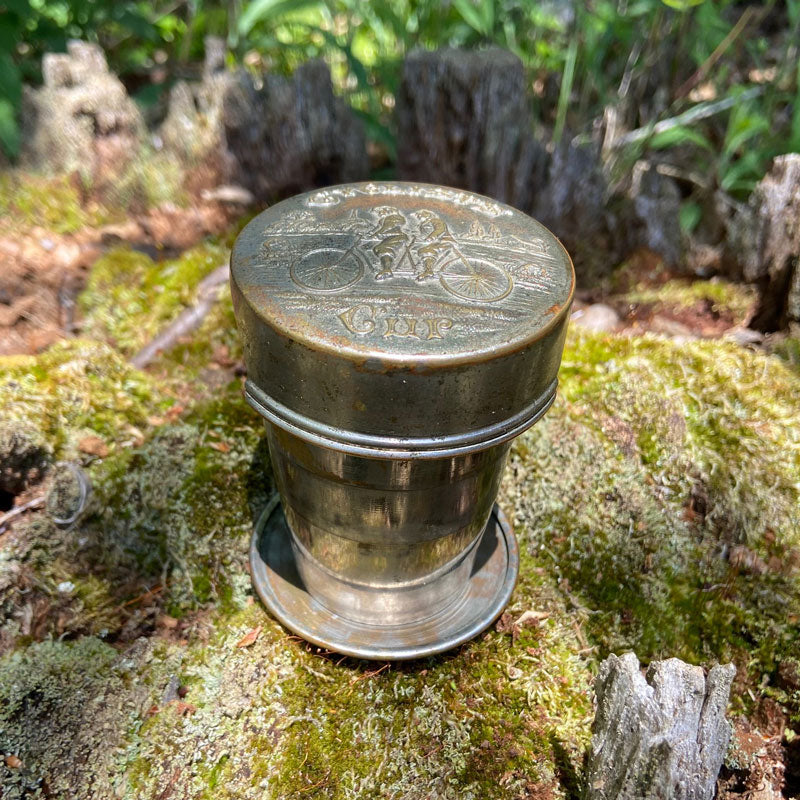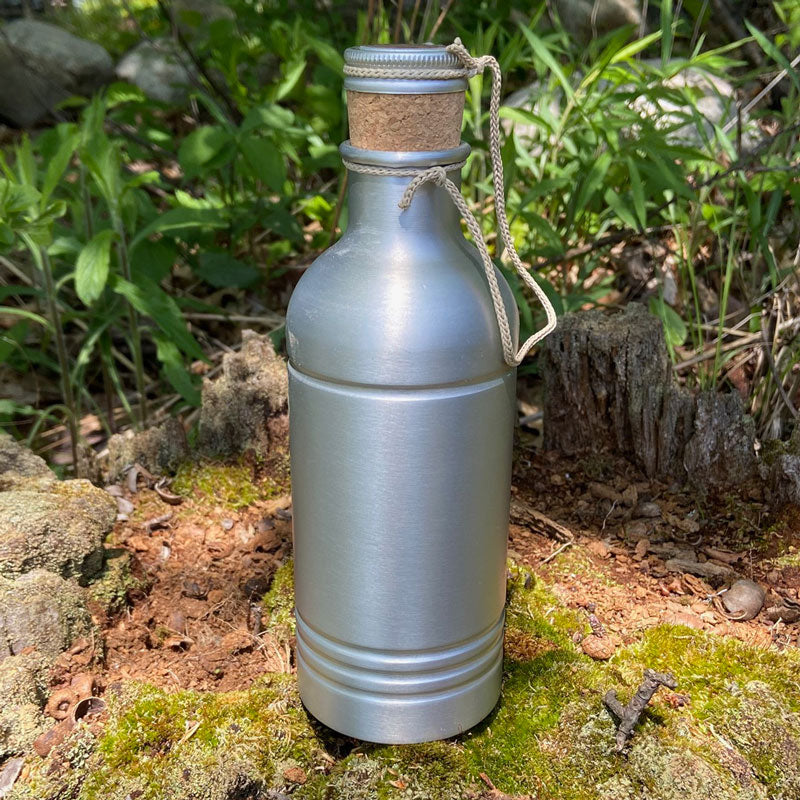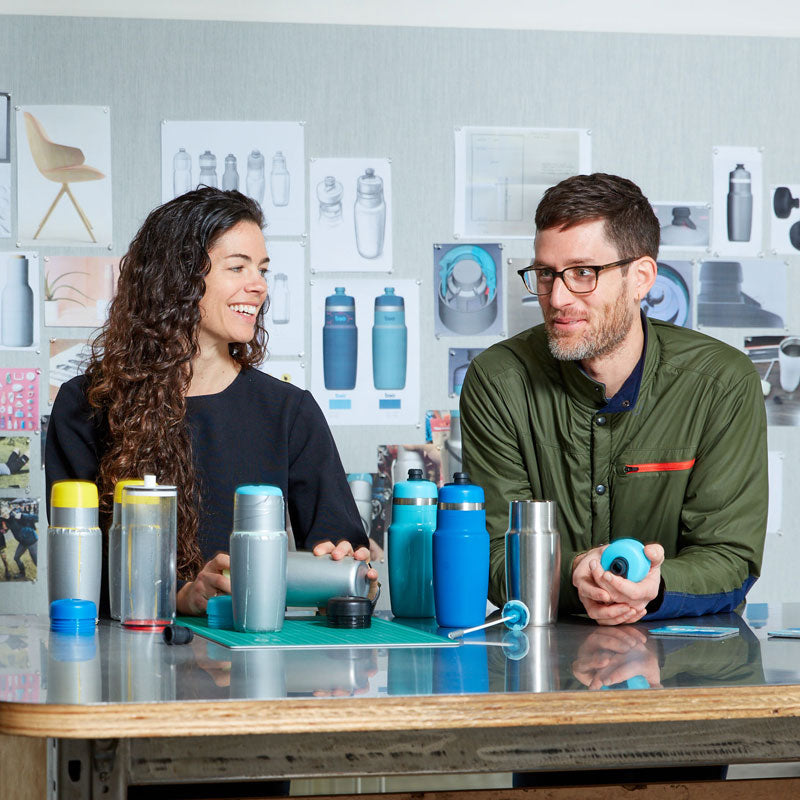Thanks for the great article!
June 1st, 2024 | by Peggy Shinn
Welcome to Quench'd #12. For this edition, we turn to a deep dive on the history of the cycling water bottle. We think you'll love this one— thanks, Peggy, for all your research. We're proud to be part of the history as modern day cycling bottle, Bivo!
As I cleaned out our overstuffed water bottle cupboard — recycling a 1987 Tour of Los Alamos plastic bidon and a moldy insulated CamelBak podium bottle (among many, many others) — I wondered about the history of the cycling water bottle.
How did the early bike riders hydrate? Balancing on a penny-farthing (aka, high wheeler) looks hard enough without freeing a hand to drink. And where would they have put a water bottle on such a contraption anyway?
Then I remembered that water was not always viewed as the life-saving elixir that it is today. For most of human existence, water was a vector of disease (cholera anyone?). Wine, beer, and tea were more widely consumed than water. And even after municipal water purification became widespread in the U.S. and Europe in the 20th century, drinking water during exercise was thought to cause cramps and nausea (just ask my high school track coach—gah!).
Cycling water bottle history is hard to come by. Photos from early Tour de France’s were the most helpful. Here’s what I found.
Welcome to Quench'd #12. For this edition, we turn to a deep dive on the history of the cycling water bottle. We think you'll love this one— thanks, Peggy, for all your research. We're proud to be part of the history as modern day cycling bottle, Bivo!
As I cleaned out our overstuffed water bottle cupboard — recycling a 1987 Tour of Los Alamos plastic bidon and a moldy insulated CamelBak podium bottle (among many, many others) — I wondered about the history of the cycling water bottle.
How did the early bike riders hydrate? Balancing on a penny-farthing (aka, high wheeler) looks hard enough without freeing a hand to drink. And where would they have put a water bottle on such a contraption anyway?
Then I remembered that water was not always viewed as the life-saving elixir that it is today. For most of human existence, water was a vector of disease (cholera anyone?). Wine, beer, and tea were more widely consumed than water. And even after municipal water purification became widespread in the U.S. and Europe in the 20th century, drinking water during exercise was thought to cause cramps and nausea (just ask my high school track coach—gah!).
Cycling water bottle history is hard to come by. Photos from early Tour de France’s were the most helpful. Here’s what I found.
British industrialist John Kemp Starley invents the first commercially successful safety bicycle (two wheels the same size, not the perilously high penny-farthing high wheeler), making cycling “safe” for everyone. The sport takes off.
British industrialist John Kemp Starley invents the first commercially successful safety bicycle (two wheels the same size, not the perilously high penny-farthing high wheeler), making cycling “safe” for everyone. The sport takes off.
John Lines of the Sovill Manufacturing Company in Waterbury Connecticut, patents a collapsible metal cyclist’s cup in 1897. Put it in a pocket, then fill it with whatever liquid you dare drink while out for a ride.
*The image to the right (or bottom onmobile) is a cup Peggy found on EBay and gifted to the Bivo team. It's a really cool piece of history to have in house!
John Lines of the Sovill Manufacturing Company in Waterbury Connecticut, patents a collapsible metal cyclist’s cup in 1897. Put it in a pocket, then fill it with whatever liquid you dare drink while out for a ride.
*The image to the right (or bottom onmobile) is a cup Peggy found on EBay and gifted to the Bivo team. It's a really cool piece of history to have in house!
Building on the popularity of long road races like Bordeaux Paris (founded in 1891) and Paris Roubaix (1896), Henri Desgrange proposes a Tour de France as a way to help his financially struggling newspaper, "L’Auto,"gain readership. Pedaling six stages ranging in length from 167 miles to a ghastly 293, sixty racers rode the first Tour with metal bottles shoved inside their jerseys, or in leather handlebar bags, or clamped to their handlebars. At mandatory checkpoints along the race routes, they filled their bottles with milk, lemonade, mixtures of water and wine, or just plain wine. They also took advantage of water fountains in villages and road-side streams and ditches. While a few, like Tour winner Maurice Garin, had a team leader providing sustenance like broth and bottles Vichy spring at each checkpoint, Tour history is full of tales of riders pillaging local bars and cafés — followed by a cigarette to “open the lungs.”
Building on the popularity of long road races like Bordeaux Paris (founded in 1891) and Paris Roubaix (1896), Henri Desgrange proposes a Tour de France as a way to help his financially struggling newspaper, "L’Auto,"gain readership. Pedaling six stages ranging in length from 167 miles to a ghastly 293, sixty racers rode the first Tour with metal bottles shoved inside their jerseys, or in leather handlebar bags, or clamped to their handlebars. At mandatory checkpoints along the race routes, they filled their bottles with milk, lemonade, mixtures of water and wine, or just plain wine. They also took advantage of water fountains in villages and road-side streams and ditches. While a few, like Tour winner Maurice Garin, had a team leader providing sustenance like broth and bottles Vichy spring at each checkpoint, Tour history is full of tales of riders pillaging local bars and cafés — followed by a cigarette to “open the lungs.”
Most bike racers carry two metal water bottles (known as bidons) affixed to their handlebars. With cork tops, these bottles are clumsy to use. Cloth bags (musettes) handed to riders mid-race by their team managers (soigneurs) often contain liquid refreshment.
Most bike racers carry two metal water bottles (known as bidons) affixed to their handlebars. With cork tops, these bottles are clumsy to use. Cloth bags (musettes) handed to riders mid-race by their team managers (soigneurs) often contain liquid refreshment.
In the early 1950s, chemists on both sides of the Atlantic discover how to transform ethylene and polyethylene into solid polymers called high-density polyethylene (HDPE) plastic. Tour de France riders begin using lightweight HDPE plastic water bottles with easy-to-drink-from nozzles.
Water bottle cages move from the handlebars to the down tube of road bikes.
University of Florida medical researchers invent Gatorade, and the Florida Gators become known as a second-half football team, able to maintain a constant level of performance throughout an entire game in sub-Tropical heat and humidity. As superstars from other sports discovered Gatorade, the electrolyte replacement business is born.
Before competing in the Hotter N’Hell 100 bike race in Texas, an emergency medical technician named Michael Eidson fills an IV bag with water and puts it in a tube sock. He pins the sock to the back of his jersey, slings the IV tube over his shoulder and clamps the tube with a clothes pin. The CamelBak is born and becomes popular with mountain bikers.
Water bottle manufacturers begin producing BPA-free plastic water bottles after reports reveal the toxicity of the endocrine disruptor.
Stainless steel water bottles become popular, but not yet for cycling. The screw-on or flip tops on these metal bottles require two hands to use, and the bottles are considered too heavy for cycling. Also, they are not designed to fit into bike water bottle cages.
In the early 1950s, chemists on both sides of the Atlantic discover how to transform ethylene and polyethylene into solid polymers called high-density polyethylene (HDPE) plastic. Tour de France riders begin using lightweight HDPE plastic water bottles with easy-to-drink-from nozzles.
Water bottle cages move from the handlebars to the down tube of road bikes.
University of Florida medical researchers invent Gatorade, and the Florida Gators become known as a second-half football team, able to maintain a constant level of performance throughout an entire game in sub-Tropical heat and humidity. As superstars from other sports discovered Gatorade, the electrolyte replacement business is born.
Before competing in the Hotter N’Hell 100 bike race in Texas, an emergency medical technician named Michael Eidson fills an IV bag with water and puts it in a tube sock. He pins the sock to the back of his jersey, slings the IV tube over his shoulder and clamps the tube with a clothes pin. The CamelBak is born and becomes popular with mountain bikers.
Water bottle manufacturers begin producing BPA-free plastic water bottles after reports reveal the toxicity of the endocrine disruptor.
Stainless steel water bottles become popular, but not yet for cycling. The screw-on or flip tops on these metal bottles require two hands to use, and the bottles are considered too heavy for cycling. Also, they are not designed to fit into bike water bottle cages.
Bivo introduces the Bivo One, a 21-oz stainless steel water bottle with a space-age nozzle designed for one-handed drinking. With colorful anti-slip silicone coatings, the bottles come in fun colors and don’t rattle in bottle cages.
Bivo introduces the Bivo One, a 21-oz stainless steel water bottle with a space-age nozzle designed for one-handed drinking. With colorful anti-slip silicone coatings, the bottles come in fun colors and don’t rattle in bottle cages.
For this series, we are working hard to find great writers and interesting people making a real impact in the cycling community. Is your friend leading inclusive group rides in your city? Are you part of a group advocating for better bike infrastructurein your town? Are you building the coolest new trail network in your neighborhood? Do you love e-bikes? Hate them? Tell us all about it! If you know someone whose work we should feature or have a story yourself, send us a note:thirsty@drinkbivo.com. Thanks!
For this series, we are working hard to find great writers and interesting people making a real impact in the cycling community. Is your friend leading inclusive group rides in your city? Are you part of a group advocating for better bike infrastructurein your town? Are you building the coolest new trail network in your neighborhood? Do you love e-bikes? Hate them? Tell us all about it! If you know someone whose work we should feature or have a story yourself, send us a note:thirsty@drinkbivo.com. Thanks!
The team reflects on some of our favorite moments from the past year. Some big, some small, all of which we couldn't have done without you, so thank you! Cheers to the new year :)
For Quench'd this week, professional cyclist Kiara Lylyk doesn't hold back when sharing stories from her time in the Tour de Femmes this past year. Racing at this level is unimaginably hard and Kiara shares with us just how hard it is. Her story is inspiring and had us on the edge of our seats.
At this office, we love nordic skiing and have been eagerly waiting for each race. We asked each of our nordic athletes to tell us a bit about how their season is going and to share some pictures of their experiences abroad racing for the US! Read what they had to say.



Carina
June 03, 2024
Glad you enjoyed it! The Florida Gator part was really cool to read!